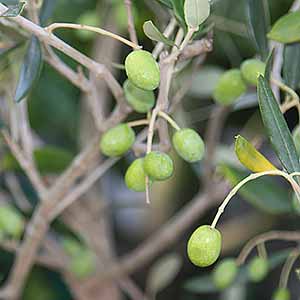
Olive trees are a versatile tree being grown for olives (fruit) olive oil production as well as for ornamental purposes.
The botanical name is Olea Europaea and they are a small growing evergreen tree originally from northern Africa and Asia but mainly associated with the Mediterranean countries where they have been developed for fruit and oil production.
They can be grown easily in USDA Zones 10 – 11, with some varieties suited to cooler zones 8 – 9.
Picual, is a smaller growing variety that will grow in Zone 7 given the right conditions.
As fruiting trees, Olives are well known, as ornamental trees they are becoming increasingly popular, typically reaching around 15ft (5m) in height, they can get to 25ft plus, however they usually grow to be a more ‘squat’ tree than tall.
As ornamentals they are admired for the twisted and gnarled trunks which develop with age. However they can also be espaliered (see right)
Also used as hedges or screens where as young trees they are particularly effective, however with age this may not work so well. Adaptable they are easily grown in containers and require little care
Olive Tree Varieties
- Arbequinae
- Arbosana
- Ascolana Tenera
- Barouni
- Coratina
- Frantoio (Sweet and heavy tasting for producing olive oli)
- Kalamata (Classic Greek Olive)
- Koreneiki
- Leccino
- Lucaca
- Manzanillo (from Spain)
- Maurino
- Pendolino
- Sevillano (Spanish Queen)
- Taggiasca
- Verdale (from France)
Olive Tree care.
Although seen as well suited to a Mediterranean climate they can be grown in much cooler areas as ornamental trees. These are a versatile tree and will grow in most soil types as long as it well drained. They do require a sunny aspect, especially if you are looking for good fruit development.
They cope with hot dry summers as this is the natural environment, however they will require some extra moisture during extended dry periods.
Young trees should be planted in a humus rich soil and preferably staked to ensure a good growth habit and prevent damage from strong winds. Once established they are a sturdy tree.
Fertilizer
Although not a particularly ‘hungry’ tree Olives do appreciate some fertilizer in spring, for the home grower a general all purpose, slow release fertilizer is usually sufficient.
In warmer areas a little pine straw mulch in summer will help retain moisture.
Pruning Olive Trees
Generally little to no pruning is required, however Olive trees do take well to pruning and shaping especially when young.
Commercial growers will prune to make fruit picking easier, home growers and landscapers to shape the canopy.
Olive trees also work well as espaliered specimens for those with smaller spaces or a sunny wall to cover.
Olive Trees are available fro sale from the following nurseries
FOUR WINDS GROWERS
phone: 877-449-4637 ext. 1
www.fourwindsgrowers.com

